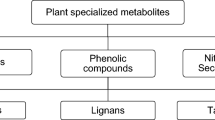Abstract
Five tempe-derived bacterial strains identified asMicrococcus orArthrobacter species were shown to transform the soybean isoflavones daidzein and glycitein to polyhydroxylated isoflavones by different hydroxylation reactions. All strains converted glycitein and daidzein to 6,7,4′-trihydroxyisoflavone (factor 2) and the latter substrate also to 7,8,4′-trihydroxyisoflavone. Three strains transformed daidzein to 7,8,3′,4′-tetrahydroxyisoflavone and 6,7,3′,4′-tetrahydroxyisoflavone. In addition, two strains formed 6,7,8,4′-tetrahydroxyisoflavone from daidzein. Conversion of glycitein by these two strains led to the formation of factor 2 and 6,7,3′,4′-tetrahydroxyisoflavone. The structures of these transformation products were elucidated by spectroscopic techniques and chemical degradation.
Similar content being viewed by others
References
Adlercreutz H, Mousavi Y, Loukovaara M, Hämäläinen E (1991) Lignans, isoflavones, sex hormone metabolism and breast cancer. In: Hochberg RB, Naftolin F (eds) The new biology of steroid hormones. Raven Press, New York, pp 145–154
Akiyama T, Ishida J, Nakagawa S, Ogawara H, Watanabe S, Itoh N, Shibuya M, Fukami Y (1987) Genistein, a specific inhibitor of tyrosine specific protein kinases. J Biol Chem 262: 5592–5595
Barz W, Weltring KM (1985) Biodegradation of aromatic extractives of wood. In: Higuchi T (ed) Biosynthesis and biodegradation of wood components. Academic Press, New York London, pp 607–666
Baumann U (1992) Gehalt und Muster von Aminosäuren während der Fermentation von Tempe durch drei Arten der GattungRhizopus. PhD thesis, University of Münster
Böger-Papendorf G (1992) Transformation von Isoflavonen durch Tempe bildende Mikroorganismen, PhD thesis, University of Münster
Campbell RVM, Harper SH, Kemp AD (1969) Isoflavonoid constitutents of the heartwood ofCordyla africana. J Chem Soc (C): 1787–1795
Cantley LC, Auger KR, Carpenter C, Duckworth B, Graziani A, Kapeller R, Soltoff S (1991) Oricogenes and signal transduction. Cell 64: 281–302
Chimura H, Sawa T, Kumada Y, Naganawa H, Matsuzaki M, Takita T, Hamada M, Takeuchi T, Umezawa H (1975) New isoflavones, inhibiting catechol-O-methyltransferase, produced byStreptomyces. J Antibiot 28: 619–626
Coward L, Barnes NC, Setchell KDR, Barnes S (1993) Genistein, daidzein, and their β-glycoside conjugates: antitumor isoflavones in soybean foods from American and Asian diets. J Agric Food Chem 41: 1961–1967
Ebata J, Fukuda Y, Hirai K, Murata K (1972) β-Glucosidase involved in the antioxidant formation in tempeh, fermented soybeans. J Agric Chem Soc Jpn 46: 323–329
Funayama S, Anraku Y, Mita A, Komiyama K, Omura S (1989) Structural study of isoflavonoids possessing antioxidant activity isolated from fermentation broth ofStreptomyces sp. J Antibiot 42: 1350–1355
György P, Murata K, Ikehata H (1964) Antioxidants isolated from fermented soybeans (tempeh). Nature 203: 870–872
Harper SH, Shirley DB, Taylor DA (1976) Isoflavones fromXan-thocercis zambesiaca. Phytochemistry 15: 1019–1023
Hirano T, Oka K, Akiba M (1989) Antiproliferative effects of synthetic and naturally occurring flavonoids on tumor cells of human breast carcinoma cell line, ZR-75-1. Res Comm Chem Path Pharm 64: 69–78
Jha HC, Bockemühl S, Egge H (1990) Adriamycin-induced mitochondrial lipid peroxidation and its inhibition by tempe-isoflavonoids and their derivatives. In: Hermana, Mien M, Karyadi D (eds) Second Asian symposium on non-salted soybean fermentation. Ministry of Health, Jakarta, pp 4–14
Keuth S, Bisping B (1994) Vitamin B12 production byCitrobacter freundii orKlebsiella pneumoniae during tempeh fermentation and proof of enterotoxin absence by PCR. Appl Environ Microbiol 60: 1495–1499
Klus K, Börger-Papendorf G, Barz W (1993) Formation of 6,7,4′-trihydroxyisoflavone (factor 2) from soybean seed isoflavones by bacteria isolated from tempe. Phytochemistry 34: 979–981
Komiyama K, Funayama S, Anraku Y, Mita A, Takahashi Y, Omura S, Shimasaki H (1989) Isolation of isoflavonoids possessing antioxidant activity from the fermentation broth ofStreptomyces sp. J Antibiot 42: 1344–1349
Kudou S, Fleury Y, Welti D, Magnolato D, Uchida T, Kitamura K, Okubo K (1991) Malonyl isoflavone glycosides in soybean seeds (Glycine max Merril), Agric Biol Chem 55: 2227–2233
Mabry TJ, Markham KR, Thomas MB (1970) The systematic identification of flavonoids. Springer, Berlin Heidelberg New York
Makishima M, Honma Y, Hozumi M, Sampi K, Hattori M, Umezawa K, Motoyoshi K (1991) Effects of inhibitors of protein tyrosine kinase activity and/or phosphatidylinositol turnover on differentiation of some human myelomonocytic leukemia cells. Leukemia Res 15: 701–708
Middleton E Jr, Kandaswami C (1992) Commentary. Effects of flavonoids on immune and inflammatory cell functions. Biochem Pharmacol 43: 1167–1179
Murata K (1988) Antioxidative stability of tempeh. J Am Oil Chem Soc 65: 799–800
Naim M, Gestetner B, Zilkah S, Birk Y, Bondi A (1974) Soybean isoflavones, characterization, and antifungal activity. J Agric Food Chem 22: 806–810
Ollis WD, Rhodes CA, Sutherland IO (1967) The extractives ofMillettia dura (dunn) the constitutions of durlettone, durmillone, milldurone, millettone and milletosin. Tetrahedron 23: 4741–4760
Peterson G, Barnes S (1991) Genistein inhibition of the growth of human breast cancer cells: independence from estrogen receptors and the multi-drug resistance gene. Biochem Biophys Res Commun 179: 661–667
Van Etten HD, Matthews DE, Matthews PS (1989) Phytoalexin detoxification: importance for pathogenicity and practical implications. Annu Rev Phytopathol 27: 143–164
Voß C, Sepulveda-Boza S, Zilliken FW (1992) New isoflavonoids as inhibitors of porcine 5-lipoxigenase. Biochem Pharmacol 32: 157–162
Author information
Authors and Affiliations
Corresponding author
Rights and permissions
About this article
Cite this article
Klus, K., Barz, W. Formation of polyhydroxylated isoflavones from the soybean seed isoflavones daidzein and glycitein by bacteria isolated from tempe. Arch. Microbiol. 164, 428–434 (1995). https://doi.org/10.1007/BF02529741
Received:
Accepted:
Issue Date:
DOI: https://doi.org/10.1007/BF02529741




